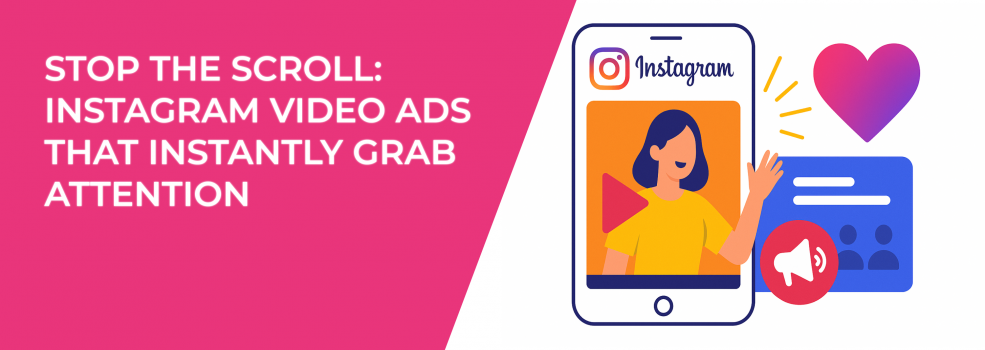Getting someone to stop scrolling on Instagram is no small feat. There’s constant movement — Reels flying by, Stories loading at the top, friends sending memes, and somewhere in the middle of it all, your video ad needs to grab attention.
So how do you break through? How do you create Instagram video ads that not only get seen, but remembered?
Let’s walk through what actually works and how to do it step by step.
1. Hook viewers in the first 3 seconds
Those opening moments are everything. They decide whether a user swipes away or leans in. The goal? Get immediate attention before the viewer even thinks about moving on.
This isn’t about being loud or aggressive. It’s about understanding what visually or emotionally triggers people to pause. Your first frame should carry some friction — something visually sharp, surprising, or emotionally charged that jars the scroll into slowing down.
Here’s how to do it:
-
Lead with action. Motion draws the eye better than static shots. Use movement that hints at a story — someone slicing something unexpectedly, an object being destroyed, or a transformation already in progress.
-
Use bold visuals. Apply high-contrast lighting, vibrant color schemes, or unfamiliar angles. It’s about contrast against the feed’s visual noise.
-
Pose a quick question on-screen. Start with a relatable or provocative question that targets a known frustration: “Still spending $50 on this?” or “Using the wrong tool every morning?”
-
Skip the intros. Every second counts. Don't waste the first two on branding or music builds. The logo can appear subtly once you’ve secured attention — not before.
Think of your opening as the headline of a story. If it doesn’t stop them cold, the rest won’t matter.
Want to dive deeper into maximizing vertical video on Instagram? Explore these Instagram Reels marketing tactics to boost visibility and relevance from the first frame.
2. Make your video ads look native, not overproduced
Instagram isn’t television: users aren’t expecting glossy, cinematic footage. They’re scrolling through personal content, so ads that look like regular posts feel more trustworthy and relatable.
When your video ad blends into the feed, it doesn’t get flagged as an ad immediately. That gives you a valuable window to connect. But if it screams “marketing,” people shut down before you’ve said a word.
Make your ads blend in naturally:
-
Shoot vertically. Don’t just crop horizontal content — actually frame it for mobile viewing. Full-screen vertical video has a higher chance of keeping viewers engaged in Reels and Stories.
-
Use real environments. A makeup tutorial shot in a bathroom feels more believable than a staged studio scene. Think lived-in, not lit-up.
-
Feature real people. Seek out micro-creators, brand advocates, or even in-house staff. Faces with personality — not polish — perform better.
-
Embrace imperfections. Slightly shaky hands, a laugh mid-line, background clutter — these small details reinforce the feeling that this is a real person sharing something, not a company selling it.
If your video feels native to Instagram, you reduce resistance. That gives your story a chance to land before the viewer realizes they’re watching an ad.
Even the most authentic ad will fall flat without the right viewers. Review these Meta ad targeting fundamentals to make sure your creative gets in front of people who’ll actually care.
3. Design for sound off, but add sound for impact
A huge percentage of Instagram users scroll with their sound off, especially in public places or while multitasking. If your message relies on someone listening, you’re taking a risky bet.
But when audio is available, it can create emotional depth and reinforce your message in powerful ways.
To get the balance right:
-
Add on-screen captions. Use high-contrast text in branded font or color that’s easy to read on a phone. Use motion to animate key words or build interest line by line.
-
Use visual storytelling. Think like a silent film director. Can someone understand the premise just by watching? Demonstrate rather than explain.
-
Include music or sound effects. A snappy audio cue, like the sound of a product snapping shut or water fizzing, adds texture. Don’t underestimate how much sensory memory sound can create.
-
Use expressive voiceovers. If your ad does include spoken audio, avoid corporate tones or stiff reads. Go conversational, energetic, even imperfect — like a friend sharing a tip.
Creating a sound-off-first experience ensures accessibility and retention, while layering in good sound offers a more immersive journey for those open to it.
4. Break the scroll pattern
Most people scroll mindlessly. To stand out, you need to interrupt that rhythm — visually, emotionally, or conceptually.
Interrupting the scroll doesn’t mean disrupting the experience negatively. It means introducing something that feels fresh — different enough to cause a pause, familiar enough to feel interesting.
Try these pattern-breaking techniques:
-
Start with a twist. Begin with something the viewer thinks they understand — then immediately flip it. For example, show a common problem but exaggerate it visually or metaphorically.
-
Change the camera angle. A top-down cooking shot, a product POV, or even a zoomed-in handheld view can feel different enough to snag attention.
-
Use quick cuts or zooms. Add tension or energy with kinetic motion. Fast edits can force the eye to pay attention — especially when paired with unexpected transitions.
-
Create contrast. Pair opposites: an elegant product with chaotic surroundings, or a silent scene followed by an audio burst. Contrast builds suspense and curiosity.
Anything that slows the viewer down for a split second gives your message room to breathe. And in the endless scroll, that’s gold. You can learn more about hooking attention through psychological triggers in our other article.
5. Create curiosity-driven CTAs
Calls to action aren’t just about telling someone what to do. They’re about making someone want to do it. The best CTAs feel like the natural resolution to the tension your video built — a payoff the viewer can’t resist.
If your CTA feels too commercial, it’ll be ignored. If it feels too vague, it’ll confuse. But if it opens a loop — creates the promise of something useful or surprising — it invites action.
How to craft better calls to action:
-
Use teaser text. Think headlines with unresolved tension: “She changed her routine for this”, or “This tiny swap made a huge difference”.
-
Keep CTAs simple. Focus on one desired action. Don’t stack “Shop now”, “Learn more”, and “Follow us” in the same clip. It creates decision fatigue.
-
Tie your CTA to the hook. If your video opens with a pain point, your CTA should imply the solution: “Get relief in under 30 seconds”.
-
Avoid shouting. People are allergic to pushy copy. Subtlety and confidence work better. A tone of helpfulness outperforms hard selling in this format.
Great CTAs don’t end the video — they open the next chapter.
6. Test small, learn big
Every viral ad started as a rough draft. Smart advertisers don’t rely on instincts alone — they rely on structured creative testing to learn what resonates.
The key is to test fast and cheap before scaling. You don’t need massive budgets to learn valuable things — just thoughtful experimentation and a willingness to discard what doesn’t perform.
Make testing part of your creative process:
-
Create variations of each concept. Test not just different topics, but different approaches to the same idea — humor vs. sincerity, demo vs. story.
-
Review your metrics beyond clicks. Look at completion rates, replays, thumb-stops, and shares. These tell you why something worked, not just if it did.
-
Test formats. Sometimes a video underperforms as a Reel but excels as a Story. The framing, timing, and context can dramatically shift perception.
-
Track creative fatigue. Even a top-performing ad has a shelf life. When performance dips, don’t panic — refresh the visual elements or swap out the opening frames.
The best campaigns don’t run one winning ad. They build a pipeline of ideas and let data guide the spotlight.
Not sure where to begin with testing variations? These key strategies for testing Facebook ads will help you run smart, structured experiments that actually reveal what works.
Final takeaway
Instagram video ads aren’t just about getting views — they’re about creating moments of meaning in a sea of distraction.
A strong creative strategy isn’t based on tricks or hacks. It’s built on clarity, intent, and a deep understanding of what people actually pay attention to.
So aim to connect, deliver value, tell a story quickly, but tell it well.
The scroll doesn’t stop for ordinary, so make your video worth noticing.

